I see there are plenties of question on EF cache, but I have found no solution yet to my problem.
The straight question is
How do I completely disable Entity Framework 6 cache? Or, can I programmatically tell EF to forget about the cache because something happened to data?
Background
First, I have inherited an application made of a strange mixture of EF (model-first to define entities) and plain old SQL (to manipulate data). What I did was to refactor the application in order to:
- Make simple queries (like
GetAll()for an entity) use EF6 LINQ - Leave complex data manipulation in SQL, using
DbContext.Database.Connectionwhen needed - Add
Spring.Websupport to enable DI and transactions (not yet)
At the current point, I have reorganized the code so that the main function of the application (running complex SQL queries on huge datasets) works as it did before, but then lookup domain entity manipulation is done smarter using as most Entity Framework as possible
As most....
One of the pages I inherited is a multi-checkbox page I'm going to show you for best understanding. I won't discuss the previous implementor's choice, because it's cheaper to fix my current problem and later refactor code than blocking development for a broken feature.
This is how the page looks like

Basically the Controller method is the following
[HttpPost]
public ActionResult Index(string[] codice, string[] flagpf, string[] flagpg, string[] flagammbce, string[] flagammdiv, string[] flagammest,
string[] flagintab, string[] flagfinanz, string[] flagita, string[] flagest, string pNew){
Sottogruppo2015Manager.ActivateFlagFor("pf", flagpf);
Sottogruppo2015Manager.ActivateFlagFor("pg", flagpg);
Sottogruppo2015Manager.ActivateFlagFor("ammbce", flagammbce);
Sottogruppo2015Manager.ActivateFlagFor("ammdiv", flagammdiv);
Sottogruppo2015Manager.ActivateFlagFor("ammest", flagammest);
Sottogruppo2015Manager.ActivateFlagFor("intab", flagintab);
Sottogruppo2015Manager.ActivateFlagFor("finanz", flagfinanz);
Sottogruppo2015Manager.ActivateFlagFor("ita", flagita);
Sottogruppo2015Manager.ActivateFlagFor("est", flagest);
return RedirectToAction("Index", new { pNew });
}
Each string[] parameter is a column in the table. The ActivateFlagFor method runs two queries in sequence
UPDATE table SET --param1-- = 0;
UPDATE table SET --param1-- = 1 where id in (--param2--)
When the cache kicks in
The following is the behaviour:
- I first load the page issuing a LINQ select: checks match the ones and zeroes in columns
- I change one or more checks and submit
- The controller issues the queries to update checks in the DB
- Before redirecting (!means new request!) to reload the page, I check the DB and the changes are applied
- The page reloads issuing the same LINQ select above: old checks are displayed
I am sure that this is a caching problem, because reloading the application fixes the problem. Since the main feature of the application is totally SQL based, changes to lookup tables are reflected into main operation and that's the correct behaviour.
I understand that EF caching is a great feature for performance, but in my case I just don't want it, at least until I migrate the whole application to LINQ DML (probably impossible).
How I use the DbContext
Of course some of you may ask "how do you use your DbContext?" "do you dispose of it correctly?".
- I haven't yet integrated Spring transactions in my Manager classes
- Each object that performs actions on the database is a
I<Entity>ManagerextendingBaseManager DbContextis a request-scoped Spring object. I already asked about disposing request-scoped objects but I currently implemented a workaround that, while bad, correctly disposes of the DbContext at the end of the request.
Example code
public class ExampleManagerImpl : BaseManager, IExampleManager
{
public void ActivateFlagFor(string aFlag, string[] aList)
{
string sql = "UPDATE table SET flag" + aFlag + " = 0";
RunStatementV1(sql);
if (aList != null && aList.Any())
{
sql = "UPDATE table SET flag" + aFlag + " = 1 WHERE id in (" + aList.ToCsvApex() + ")";
RunStatementV1(sql);
}
}
public IList<Models.Example> GetAll()
{
return DataContext.example.ToList(); //I don't dispose of the DataContext willingly
}
}
and
public abstract class BaseManager {
public DbContext DataContext { get; set; } //Autowired
protected void RunStatementV1(string aSqlStatement)
{
IDbConnection connection = DataContext.Database.Connection;
if (connection.State == ConnectionState.Closed || connection.State == ConnectionState.Broken) connection.Open(); //Needed because sometimes I found the connection closed, even if I don't dispose of it
using (IDbCommand command = connection.CreateCommand())
{
command.CommandText = aSqlStatement;
command.ExecuteNonQuery();
}
}
}
What I tried
- How to stop entity framework caching : disabling lazy loading didn't work
- https://stackoverflow.com/a/22818783/471213:
Detachseems to solve the problem but I'd need to apply it to dozen of entities, in order to revert someday in the future